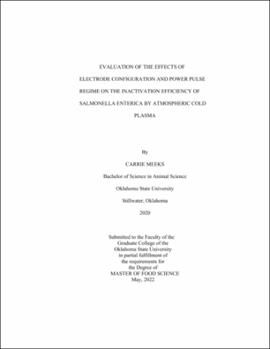| dc.contributor.advisor | Ma, Li Maria | |
| dc.contributor.author | Meeks, Carrie Sue | |
| dc.date.accessioned | 2023-03-17T21:06:37Z | |
| dc.date.available | 2023-03-17T21:06:37Z | |
| dc.date.issued | 2022-05 | |
| dc.identifier.uri | https://hdl.handle.net/11244/337132 | |
| dc.description.abstract | Effective food decontamination method is critical in safeguard food safety in fresh produce worldwide. While there are several commercially available methods for food decontamination many are unsustainable or lack consumer approval. Our research team has constructed a novel ACP device based on surface dielectric barrier discharge (SDBD) for fresh produce decontamination, however, there many variables related to device design and operational conditions can be further evaluated to improve foodborne pathogen inactivation by the device. Therefore, this thesis aimed to evaluate the effect of electrode configuration and power pulse regime on the inactivation efficiency of foodborne pathogen Salmonella enterica by the ACP device. Glass coverslips spot- inoculated with a five-strain mixture of S. enterica strains were used as ACP treatment subjects initially to evaluate the performance of the device under variable electrode width, electrode gaps, and power pulsing regime. Native pecans were used as ACP treatment targets under the selected best performance conditions. The results showed that electrode width at 0.5 cm (A3) & electrode gaps at 0.1 (A1 and A2) or 0.5 mm (A3) had the best inactivation rates of S. enterica cells on glass coverslips. Additionally, A3 had the lowest average final treatment temperature. Taken all together, A3 was selected to evaluate the power pulsing regime. Among the power pulsing regime tested, 2cm distance with 30 seconds of treatment with 5 second off pulse following 20 or 30 second off pulse for 4.5 minutes was acceptable with log reduction & final temperature. Finally, inactivation studies using S. enterica inoculated native pecans revealed that ACP treatment can reduce the recoverable colony forming units from the native pecans. Unfortunately, the actuator used in the native pecan studies were not in full function, therefore, the ACP tests using inoculated native pecans will be further carried out in the near future. In conclusion, in this study we evaluated the design of the actuators, physical parameters, length of treatment & output of plasma in CAP on the inactivation efficiency of Salmonella enterica on native pecans and found there to be an effect. This finding is helpful for advancing the use of CAP in food decontamination. | |
| dc.format | application/pdf | |
| dc.language | en_US | |
| dc.rights | Copyright is held by the author who has granted the Oklahoma State University Library the non-exclusive right to share this material in its institutional repository. Contact Digital Library Services at lib-dls@okstate.edu or 405-744-9161 for the permission policy on the use, reproduction or distribution of this material. | |
| dc.title | Evaluation of the effects of electrode configuration and power pulse regime on the inactivation efficiency of Salmonella enterica by atmospheric cold plasma | |
| dc.contributor.committeeMember | Bowser, Tim | |
| dc.contributor.committeeMember | Ramanathan, Ranjith | |
| osu.filename | Meeks_okstate_0664M_17578.pdf | |
| osu.accesstype | Open Access | |
| dc.type.genre | Thesis | |
| dc.type.material | Text | |
| dc.subject.keywords | ACP | |
| dc.subject.keywords | food | |
| dc.subject.keywords | food safety | |
| dc.subject.keywords | inactivation | |
| thesis.degree.discipline | Food Science | |
| thesis.degree.grantor | Oklahoma State University | |
